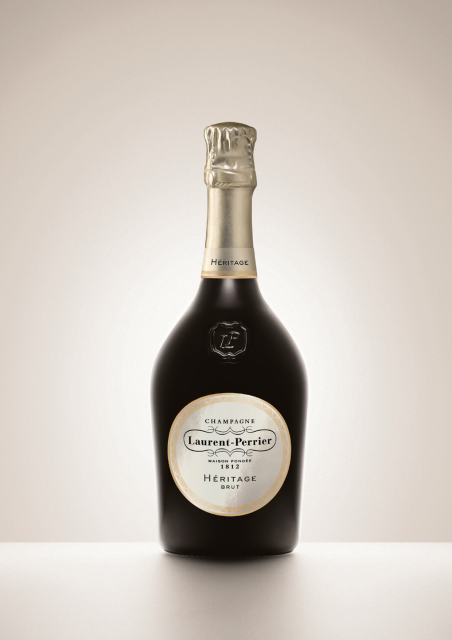Laurent-Perrier launches ‘little sister’ for its Grand Siècle multi-vintage Champagne
Laurent-Perrier launched a new multi-vintage blend in London yesterday that seeks to plug a gap between its Brut NV and prestige cuvée, Grand Siècle.

Called Heritage, it comes with a recommended retail price of £75, providing a “steppingstone” from the producer’s entry-level non-vintage Champagne, called La Cuvée – priced around £45 in the UK – and its top expression, Grand Siècle, which retails for £200.
Dubbed the “second wine of Grand Siècle” by Groupe Laurent-Perrier chairman Stéphane Dalyac, or “Petit Siècle” by wine writer Anthony Rose – who attended the launch event in 67 Pall Mall on Thursday – Heritage follows similar principles to the maison’s prestige cuvée, making it a baby sibling to the top expression.
This means Heritage is a Chardonnay-dominant (55%) blend with Pinot Noir that employs a range of vintages – four in the case of the inaugural expression, which is one more than Grand Siècle, which always incorporates wines from three different years (unlike the majority of prestige cuvées, which tend to be from a single harvest).
Targeted at restaurants, managing director at Laurent-Perrier UK, Adam Guy told the drinks business that Heritage filled a hole in the brand’s range of white, multi-vintage expressions.
“Essentially, for Laurent-Perrier blanc Champagne cuvées, we now have three levels: La Cuvée, Heritage and Grand Siècle,” he began.
Continuing, he said, “With Heritage, we are trying to offer the same sort of experience that you get with Grand Siècle in terms of reserve wines and reductive winemaking” – referring to the producer’s focus on a non-oxidative style of Champagne.
As for the positioning, he said that Heritage would serve “some accounts who have La Cuvée and Grand Siècle with nothing in the middle, so Heritage could be a steppingstone.”
He added, “In other places, it will offer scope to go above La Cuvée, but not as high as Grand Siècle.”
As for further Champagnes in the Laurent-Perrier range, he said that they are almost seen as separate entities, with the Ultra Brut and Blanc de Blancs both being zero dosage expressions, while the vintage eschews the “house style” to reflect the characters of a particular harvest. Then, when it comes to the pink Champagnes, for which the house is most famous, they also stand apart.
According to Laurent-Perrier cellar master Michel Fauconnet, the idea to make a multi-vintage premium blanc cuvée came to him in 2012, but began in earnest with the 2014 vintage, meaning that Heritage has taken more than 10 years to bring to market.
Partner Content
“We have always been looking at what we could do with our reserve wines that aren’t released as a vintage,” Fauconnet told db, adding, “We watch how they evolve, and with 2014, we thought we have something here.”
Indeed, the launch expression of Heritage incorporates wines from the ’14, ’16, ’18 and ’19 harvests, with Fauconnet commenting that the ’14 vintage was for “freshness” (representing 20% of the blend); the ’16 for “structure” (20%), the ’18 for “richness” (30%), and finally the ’19 for “finesse” (30%).
Employing not only wines from four vintages, but also 40 crus in Champagne, half of which are grands crus, Fauconnet told db that Heritage employs more “elements” than Grand Siècle, giving him “greater choice” – including sourcing Chardonnay and Pinot Noir from top sites in the Aube: Sézanne and Les Riceys respectively.
However, compared to Grand Siècle, which only employs Champagne’s best wines from the greatest harvests, he added that it was “harder to achieve complexity” with Heritage.
Notably, Fauconnet said that the crafting of Heritage was made possible due to Champagne’s system of encouraging producers to make and store wines for future use – known as vin de réserve.
“Now in Champagne we have about a year’s worth of harvest in reserve, and it is across different vintages, which gives us an amazing ability to blend things within the style of the house – which is to keep our preference for Chardonnay and reductive wines,” he said.
Concluding on this topic, he said that the role of reserve wines in bringing stylistic consistency, as well as complexity to Champagne, was a key competitive advantage for the region relative to other traditional method sparkling wines.
“This is the novelty of Champagne – to use all these reserve wines,” he stated.
Heritage was disgorged in December 2023 with a 6g/l dosage, with the blend of vintages undergoing four years ageing on lees.
Further blends will be released in coming years, incorporating a different mix of vintages, with no fixed number of harvests featuring in the blend – unlike Grand Siècle, which only uses wines from three different years.
Read more
Laurent-Perrier ups the emphasis on its prestige cuvée
Related news
Castel Group leadership coup escalates
For the twelfth day of Christmas...
Zuccardi Valle de Uco: textured, unique and revolutionary wines




